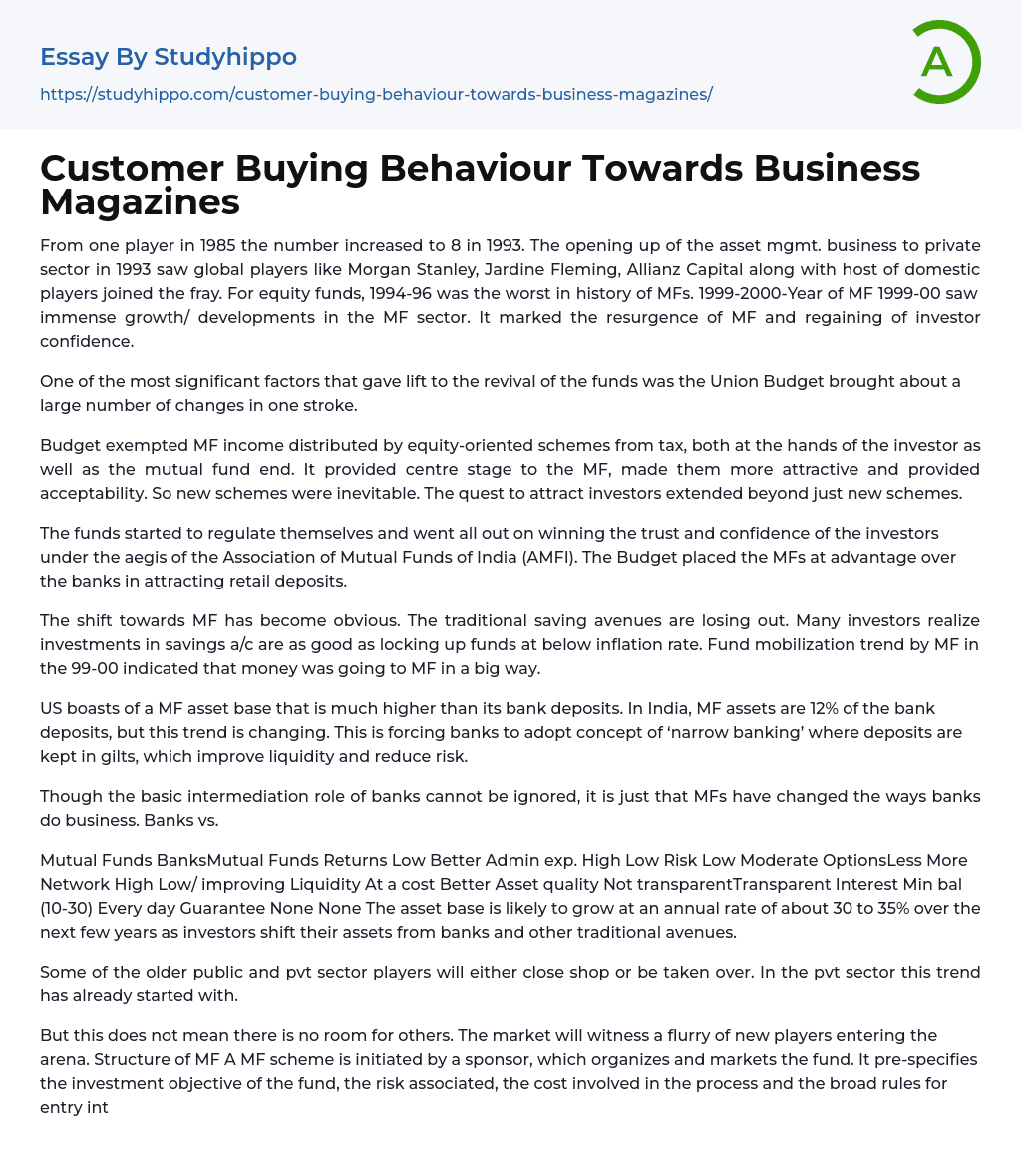

Customer Buying Behaviour Towards Business Magazines Essay Example
The number of players in the asset management business increased from one in 1985 to eight in 1993, when the private sector was opened up to global players such as Morgan Stanley, Jardine Fleming, and Allianz Capital, as well as domestic players. The years 1994-96 were the worst in the history of MFs for equity funds. However, 1999-2000 marked immense growth and development in the MF sector, as well as the regaining of investor confidence. One of the reasons for this resurgence was the Union Budget, which exempted MF income distributed by equity-oriented schemes from tax. This move made MFs more attractive and acceptable, leading to the introduction of new schemes. The Association of Mutual Funds of India (AMFI) played a role in regulating the industry and building investor trust. The Budget also gave MFs an advantage o
...ver banks for attracting retail deposits. As a result, a shift towards MFs has become evident, as traditional saving avenues are losing their appeal to investors who recognize that savings accounts offer returns below inflation rates.The trend of fund mobilization by mutual funds (MF) in the late 1990s and early 2000s showed a significant amount of money going towards MFs, resulting in the United States having a much higher MF asset base than bank deposits. In India, MF assets make up only 12% of bank deposits, but this is changing. As a result, banks are adopting the concept of "narrow banking," where deposits are kept in gilts to improve liquidity and reduce risk. While banks still play an important role in intermediation, MFs have changed the way banks do business. In terms of returns, administration expenses, and risk,
MFs often outperform banks. The asset base of MFs is expected to grow at an annual rate of 30-35% over the next few years. As a result, some older public and private sector players may close or be taken over. However, new players will also enter the market. A MF scheme starts with a sponsor who organizes and markets the fund and sets investment objectives, risks, costs, and rules for entry and exit.The sponsor of an Asset Management Company (AMC) in India typically requires approval from SEBI, which assesses their track record and financial strength. The sponsor promotes the AMC, in which they often hold a majority or even 100% stake. One example is Birla Global Finance, the sponsor of Birla Sun Life Asset Mgmt Company Ltd., which manages various mutual fund (MF) schemes. The AMC invests the funds in accordance with the investment objective and employs a custodian to manage the assets of the fund, including receiving all forms of cash and non-cash benefits. The custodian is typically a financially secure bank or institution. Many AMCs also hire a registrar and transfer agent to handle unit transactions, account statements, certificates, and investor services. The AMC reports to trustees who safeguard investor interests and ensure compliance with SEBI guidelines across all aspects of fund operations, including oversight of the custodian and transfer agent.Mutual Funds (MFs) are registered trusts under the Indian Trust Act, administered by a trustee company promoted by the sponsor. The trustees supervise the operations of the custodian/transfer agent and monitor the performance of the Asset Management Company (AMC), ensuring compliance with SEBI guidelines while safeguarding the interests of investors in the MF.
The trustees play a vital role in ensuring that the AMC does not provide any unfair advantage to any associate or compromise the interest of investors in any scheme, managing each independently. They are accountable for and custodians of scheme funds and property while periodically reviewing service contracts, such as custody and transfer of securities, to eliminate conflicts of interest between AMC fund deployment and unitholder interests.To ensure proper redressal of investor complaints, the AMC must fulfill its duties as mandated by Sebi. Maintaining proper books of accounts, records, and documents for each scheme is necessary to explain transactions and disclose the financial position of each scheme at any point in time. The accounting policies and standards should be followed for fair and accurate representation to unit-holders. All expenses must be identified and apportioned individually for each scheme, with a limit on fees and expenses. In schemes launched without a load, the AMC can collect an additional management fee not exceeding 1% of the weekly average net assets outstanding in each financial year. The MF can also be charged for expenses like initial launching, marketing/selling expenses, agent commission, brokerage, audit fees, transaction costs, custodian fees, insurance costs, etc.
- Commercial Bank essays
- Debit Card essays
- Deposit Account essays
- Subprime Lending essays
- Investing essays
- Asset essays
- Depreciation essays
- Discounted Cash Flow essays
- Foreign Direct Investment essays
- Funds essays
- Internal Rate Of Return essays
- Revenue essays
- Day Trading essays
- Futures Trading essays
- Capital market essays
- Million essays
- Payment essays
- Rate Of Return essays
- Funding essays
- Hedge Fund essays
- Bank essays
- Banking essays
- Corporate Finance essays
- Credit Card essays
- Currency essays
- Debt essays
- Donation essays
- Enron Scandal essays
- Equity essays
- Financial Accounting essays
- Financial Crisis essays
- Financial News essays
- Financial Ratios essays
- Financial Services essays
- Forecasting essays
- Foreign Exchange Market essays
- Free Market essays
- Gold essays
- Investment essays
- Legacy essays
- Loan essays
- Market Segmentation essays
- Money essays
- Personal finance essays
- Purchasing essays
- Retirement essays
- Shareholder essays
- Stock Market essays
- Supply And Demand essays
- Venture Capital essays



